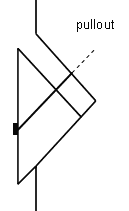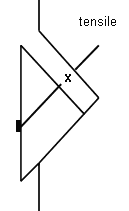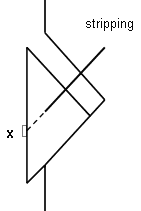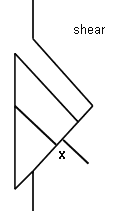Bolt Failure Modes
There are six bolt failure modes which can be reported in UnWedge:
- Pullout
- Tensile
- Stripping
- Shear
- User-Defined
- Compression
The bolt failure mode is listed in the Data Tips information when you hover the mouse over a bolt in the 3D wedge views. The failure mode is also indicated when you display the Force Diagrams for the bolts. This can be done through Display Options or the right-click menu. The different modes will be colour-coded on the Force Diagrams, and a legend will be displayed. Bolts can also be displayed according to failure mode with the Bolt Visibility option.
Pullout / Tensile / Stripping
These are all tensile failure modes and are determined by the Bolt Force Diagram, and the point at which a wedge plane intersects the bolt. For examples of bolt force diagrams, see the Bolt Force Diagram topic, and the topics for the individual bolt types in UnWedge (e.g. Cable Bolt, Swellex etc).



Shear
The Shear failure mode will only be reported if:
- The "Use Shear Strength" option is selected, for a given bolt type.
- A bolt intersects a sliding plane of a wedge (as opposed to a dilating plane)
See the Bolt Shear Strength and Bolt Support Force topics for more information.

User-Defined
If a bolt failure mode is reported as User Defined, this simply means that the bolt (tensile) properties have been defined with a User-Defined bolt type (i.e. the user creates an explicit Bolt Force diagram, rather than entering tensile properties). For more information, see the User Defined Bolt topic.
Compression
The Compression failure mode will only be reported under the following circumstances:
- The bolt intersects a sliding plane of a wedge, and the deformation mode of the bolt is mode F (as illustrated in the Bolt Support Force topic).
- Bolt Efficiency is ON.
- Bolt Shear Strength ("Use Shear Strength" checkbox) is OFF.
Only if all three of these conditions apply, will Compression be reported as a bolt failure mode.